Study Predicts Political Beliefs With 83 Percent Accuracy
Scans show that liberals and conservatives use different parts of the brain when they take risks, helping to pinpoint the political party a person prefers
![]()
If you want to know people’s politics, tradition said to study their parents. In fact, the party affiliation of someone’s parents can predict the child’s political leanings about around 70 percent of the time.
But new research, published yesterday in the journal PLOS ONE, suggests what mom and dad think isn’t the endgame when it comes to shaping a person’s political identity. Ideological differences between partisans may reflect distinct neural processes, and they can predict who’s right and who’s left of center with 82.9 percent accuracy, outperforming the “your parents pick your party” model. It also out-predicts another neural model based on differences in brain structure, which distinguishes liberals from conservatives with 71.6 percent accuracy.
The study matched publicly available party registration records with the names of 82 American participants whose risk-taking behavior during a gambling experiment was monitored by brain scans. The researchers found that liberals and conservatives don’t differ in the risks they do or don’t take, but their brain activity does vary while they’re making decisions.
The idea that the brains of Democrats and Republicans may be hard-wired to their beliefs is not new. Previous research has shown that during MRI scans, areas linked to broad social connectedness, which involves friends and the world at large, light up in Democrats’ brains. Republicans, on the other hand, show more neural activity in parts of the brain associated with tight social connectedness, which focuses on family and country.
Other scans have shown that brain regions associated with risk and uncertainty, such as the fear-processing amygdala, differ in structure in liberals and conservatives. And different architecture means different behavior. Liberals tend to seek out novelty and uncertainty, while conservatives exhibit strong changes in attitude to threatening situations. The former are more willing to accept risk, while the latter tends to have more intense physical reactions to threatening stimuli.
Building on this, the new research shows that Democrats exhibited significantly greater activity in the left insula, a region associated with social and self-awareness, during the task. Republicans, however, showed significantly greater activity in the right amygdala, a region involved in our fight-or flight response system.
“If you went to Vegas, you won’t be able to tell who’s a Democrat or who’s a Republican, but the fact that being a Republican changes how your brain processes risk and gambling is really fascinating,” says lead researcher Darren Schreiber, a University of Exeter professor who’s currently teaching at Central European University in Budapest. “It suggests that politics alters our worldview and alters the way our brains process.”
Politics isn’t the first to cause structural changes in the brain. More than a decade ago, researchers used brain scans to show that London cab drivers’ gray matter grew larger to help them store a mental map of the city. There more time they spent on the road, the bigger their hippocampi, an area associated with navigation, became.
This implies that despite the political leanings seen through our brains, how we vote—and thus the cause of our political affiliations—may not be set in stone, Schreiber says.
“If we believe that we’re hardwired for our political views, then it’s really easy for me to discount in you in a conversation. ‘Oh, you’re just a conservative because you have a red brain,’ or ‘Oh, you’re a liberal because you have a blue brain,’” Schreiber explains. “But that’s just not the case. The brain changes. The brain is dynamic.”
/https://tf-cmsv2-smithsonianmag-media.s3.amazonaws.com/accounts/headshot/marina-koren-240.jpg)

/https://tf-cmsv2-smithsonianmag-media.s3.amazonaws.com/accounts/headshot/marina-koren-240.jpg)